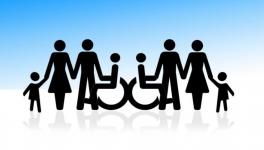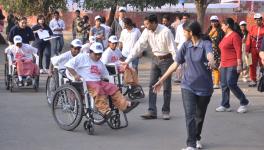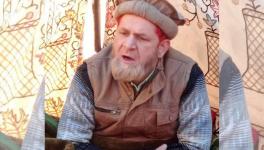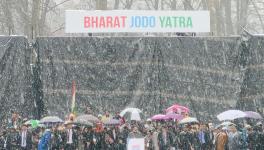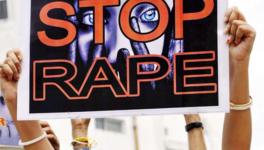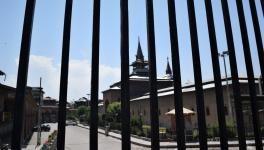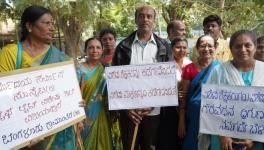Their Journey of Friendship Began in Hospital, Faces Pierced by Pellets
Shabroza Akhtar,Ifrah Shakoor,Shabroza Mir
When the first time the three teenage girls met, they had bandages wrapped all over their faces and eyes. Their friendship started from ward number 7 of Sheri Maharaja Hari Singh Hospital (SMHS).
All of them were hit with pellets on October 31, 2016 – the 115th day of continuous day and night curfew in Kashmir that had started after the killing of Hizbul Mujahedeen’s commander Burhan Wani on July 9, 2016. At around 1:30 pm, a troop of Indian Army’s Rashtriya Rifles (RR) 53 battalion posted in Rohmoo, a village in South Kashmir’s Pulwama district, were patrolling in the area. A few soldiers reportedly asked the boys who were sitting near a gate to remove the posters paying tributes to Wani from the walls and the electric poles. When the boys resisted, the army men started allegedly thrashing them. People came out of their houses to rescue the kids, and in response, the army fired pellets and bullets at them, which led to clashes in the area, according to the locals.
The clashes reportedly intensified after many youngsters were hit with pellets.
Shabroza Mir, then a 16-year old girl, was alone in her house, as her family was visiting her sister-in-law. Youngest among the five siblings, Shabroza quickly locked the doors and windows of her house when she heard the sounds of tear gas canisters and firing outside. “I was feeling suffocated due to the pepper, chilli and tear gas, so I decided to go to my uncle’s home, which is behind our house,” she recalls.
Shabroza Mir
After stepping out, she moved really fast. However, when she was about to turn at the corner, she found some of the officers of the Special Operations Group (SOG) of J&K police running towards her house, perhaps chasing the stone-pelters.
“So, I sat near the corner of my house, I turned my head back to check whether they have left yet or not. But before I could realise what was happening, one of the men in uniform fired pellets directly at my face,” says Shabroza. She was then taken to the sub-district hospital from where she was referred to SMHS.
Ifrah Shakoor, then a 14-year-old girl, was sitting inside her home which is a few metres away from Shabroza’s house. When the clashes intensified, her mother Fareeda Bano asked her to look for her younger brother Rayees who is now 10 years old, as he was playing outside with other kids.
When she went out to check on her brother, and opened the gate, within no time, a cop allegedly fired directly at her face. It was a cartridge of pellets. “The cops saw me in a girl’s dress. They fired at me anyway. They grabbed me by my hair, and beat me black and blue. A few guys managed to rescue me, but only after they too were hit with pellets,” alleges Ifrah.
Like Shabroza, locals took her too to the sub-district hospital of Pulwama by the locals. She was referred to SMHS, was coincidentally assigned a bed to the left of Shabroza.
Both their houses are located in Karl-e-Baal (mountain of potters). Following the clashes, people from the region were aware of the situation, and many of them decided to assemble at one place for safety.
From the other side of Baal, a group of SOG and RR soldiers was reportedly heading towards the spot where clashes were taking place. They saw the group of people standing in the courtyard, and allegedly shot pellets at them. To see what was happening, then 16 years old Shabroza Akhtar looked back, but even before she could figure out what had happened, her face and eyes were riddled with several pellets. She was admitted in the same ward, with her bed on the right side of Shabroza Mir.
Shabroza Akhtar
Living in the same village, but strangers to each other, all the three girls were operated on the same day, and were introduced to each other by their parents.
“I heard my mother talking to Ifrah’s mother. She told me that they are from our village itself. So, we started talking to each other,” says Mir.
Ifrah was a class VIII student, and was preparing for her exams, but couldn’t appear owing to her injuries.
Mir and Akhtar were studying in the same school, both were in class X, but in different sections. “We had seen each other on occasion, but we had never spoken,” said Mir.
For three days, all of them were talking to each other, without being able to see. They narrated how they were fired at, and were trying to relax with each other.
After three days, when the bandage was removed from their eyes, both Shabroza Mir and Ifrah were not able to see from either of their eyes. Ifrah had pellets in both her eyes, while Shabroza Mir had been hit with a pellet in her left eye, and her right eye was hit by an empty cartridge, making her vision blurry. Shabroza Akhtar had lost 75 per cent visibility in her left eye.
On realising that they had been blinded or partially blinded, they cried. The other patients from the whole ward and their relatives tried to console them, but the fact was that there was no cure, and their world was going to be deprived of light .
“There is no possibility of eye transplant either because all of us had major injuries in the retina,” says Shabroza Mir.
After seven days in the hospital, the three girls were discharged from the hospital, and were asked to visit again after seven days for another surgery, as pellets were still in their eyes.
On November 14, an ambulance was waiting for the girls to leave for SMHS (during those days only ambulances and armed vehicles were allowed to move). Onboarding, the girls decided to sit next to each other, and started talking about the severe effects of anaesthesia injection which they felt was a qahar (disaster).
“We weren’t able to talk freely, as our parents were sitting next to us, so we decided to talk our hearts out when we reach the operation theatre,” recollects Shabroza Mir.
After crossing many police checkpoints, they reached the hospital, and joined the queue where other pellet victims were waiting for their turn.
Girls were busy cracking jokes about the announcer who would call out names really loud, which seemed to annoy all the patients. They were getting nervous as they were getting closer to their turn, no one was expecting to be first.
Finally, the announcer called out the name, “Shabroza Akhtar”, and she went inside. Her screams could be heard from the theatre as she was given an injection in her eye, remember Mir and Ifrah.
Ifrah Shakoor
After Akhtar, it was Ifrah’s turn, but little Ifrah didn’t scream, which relieved Mir a bit, and another surgery was carried out. Mir’s right eye was recovering, but she had lost the vision of her left eye. Ifrah had only 20 per cent visibility in her left eye, and is completely blind from her right eye. Shabroza Akhtar had 35 per cent visibility in her left eye, while the right eye is unaffected.
Spending seven more days in ward no. 7, they got a chance to strengthen their bond. “We would discuss what happened, and would wonder if someone would marry us in future,” said Shabroza Mir.
They were discharged, but were given different dates for their third surgery, which upset them.
On reaching their villages, they said their goodbyes, but with a promise to stay in touch. They started meeting once a week. They had to drop their education due to their disability, but they tried to help each other to get over the trauma, however, with little help from society.
Mir says, “Once my mother had an argument with a neighbour, who made fun of me because of my eye.”
Once a badminton champion, Shabroza Mir is now asking her family to shift her to her maternal home, as people always remind her of, and tease her about her disability.
“I don’t reply to any taunts, I have left everything up to my Allah (God). He will help me to survive,” says Mir.
Get the latest reports & analysis with people's perspective on Protests, movements & deep analytical videos, discussions of the current affairs in your Telegram app. Subscribe to NewsClick's Telegram channel & get Real-Time updates on stories, as they get published on our website.









